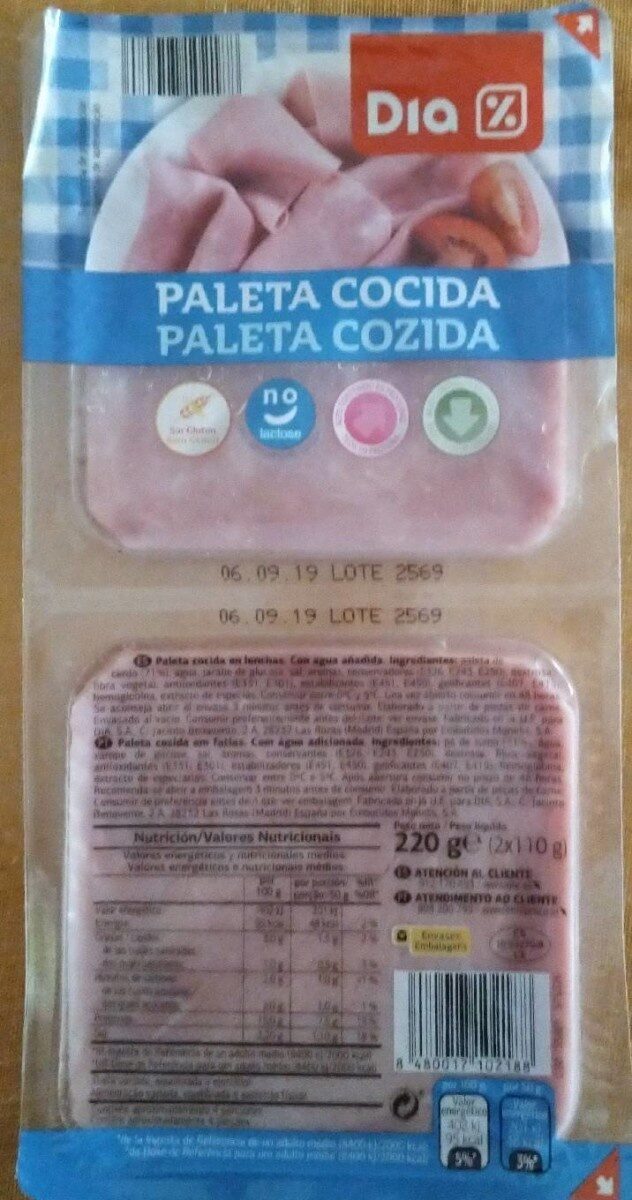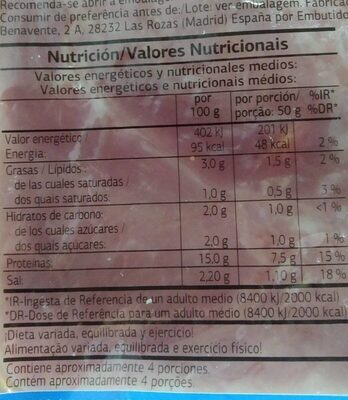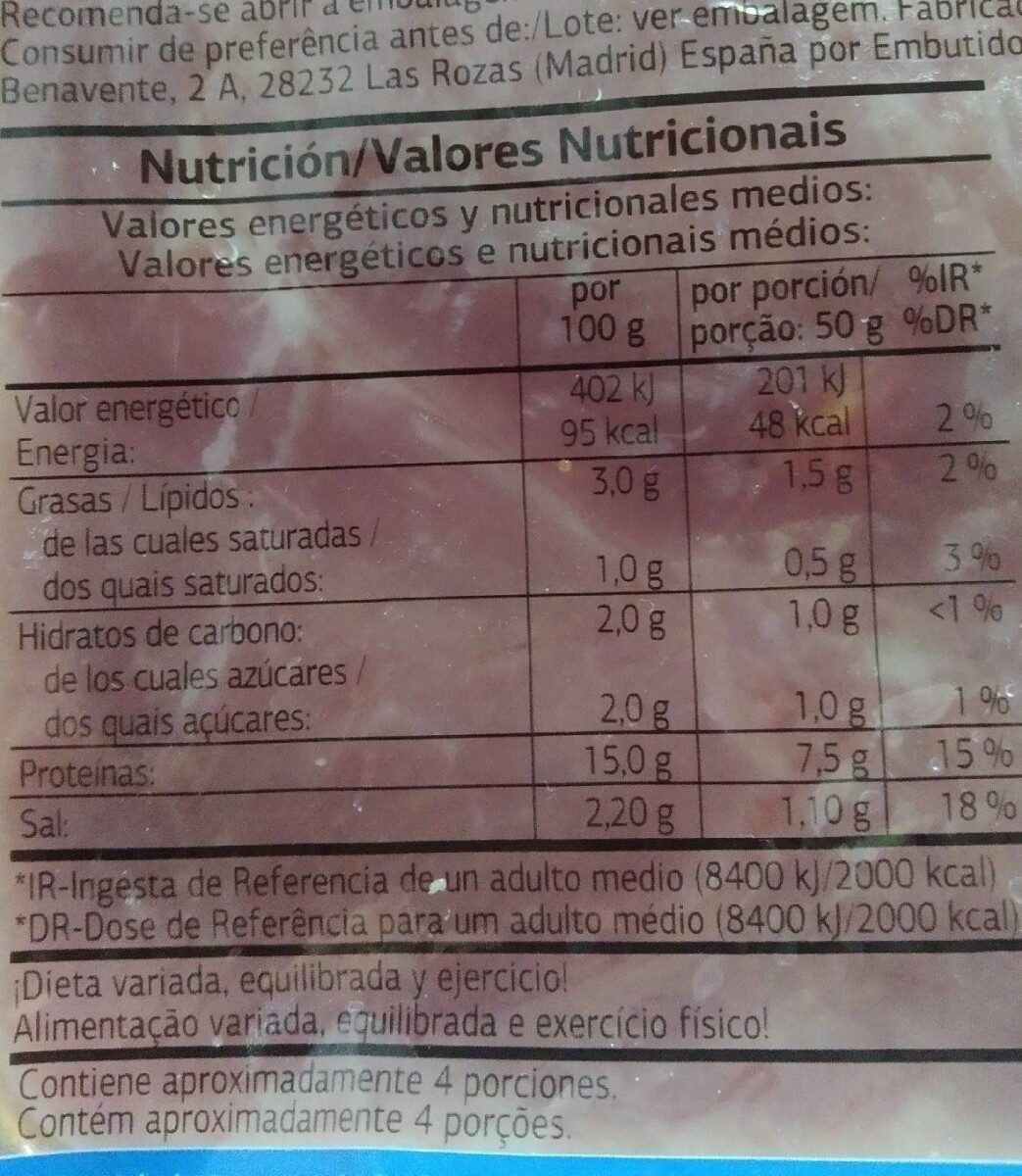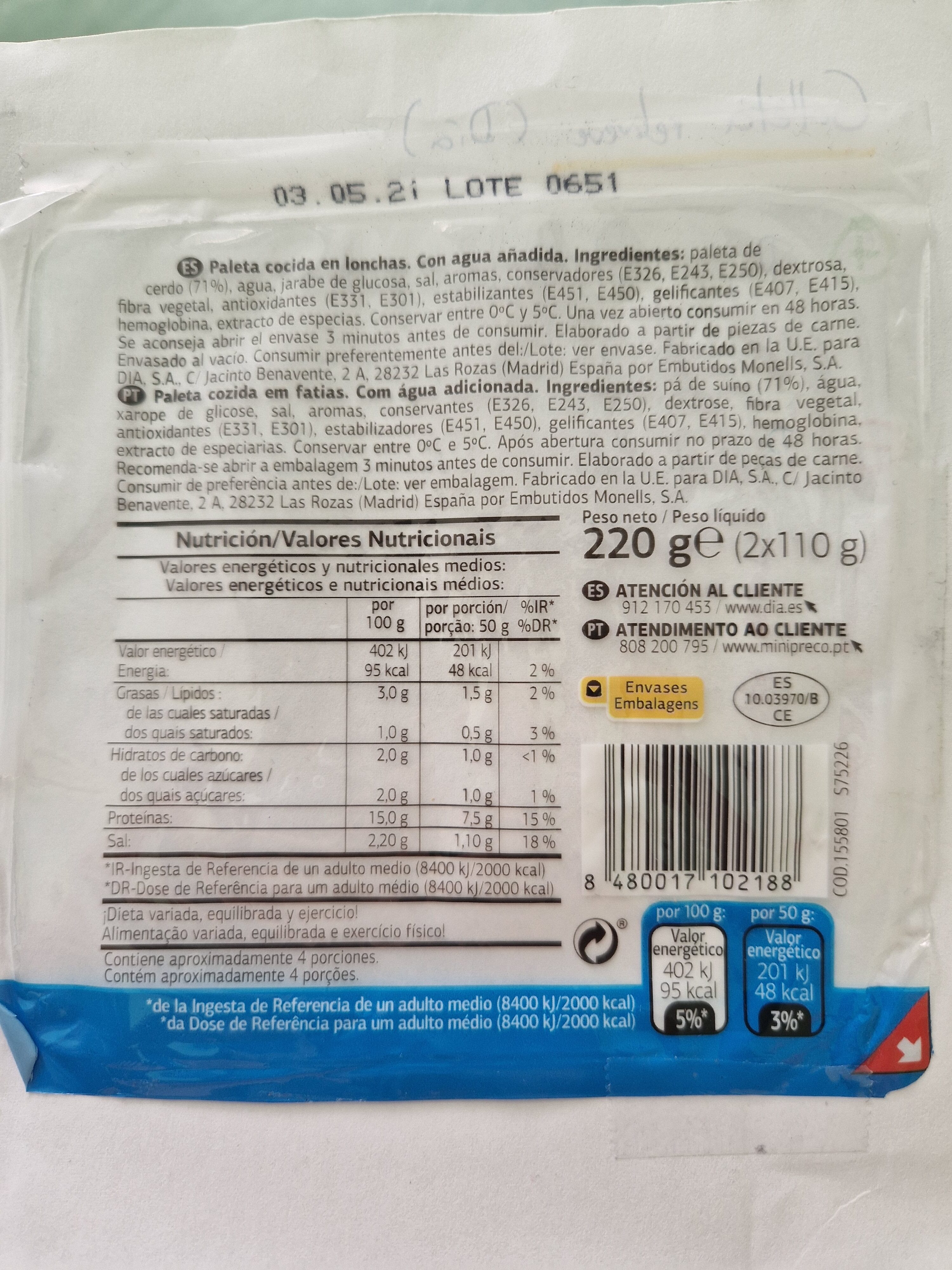Help us make food transparency the norm!
As a non-profit organization, we depend on your donations to continue informing consumers around the world about what they eat.
The food revolution starts with you!
Paleta cocida - Dia - 220 g
Paleta cocida - Dia - 220 g
This product page is not complete. You can help to complete it by editing it and adding more data from the photos we have, or by taking more photos using the app for Android or iPhone/iPad. Thank you!
×
Barra-kodea: 8480017102188 (EAN / EAN-13)
Kopurua: 220 g
Ontziratzea: en:Plastic
Markak: Dia
Kategoriak: en:Meats and their products, en:Meats, en:Prepared meats, en:Hams, en:White hams
Etiketak, ziurtagiriak, sariak:
en:No gluten, en:Green Dot, en:No lactose
Saltzen diren herrialdeak: Espainia
Matching with your preferences
Health
Osagaiak
-
22 ingredients
: paleta de cerdo (71%), agua, Jarabe de glucosa, sal, aromas, conservadores (E326, E243, E250), dextrosa, fibra vegetal, antioxidantes (E351, E301), estabilizantes (E451, E450), gelificantes (E407, E415), hemoglobina, extracto de especias.
Food processing
-
Ultra processed foods
Elements that indicate the product is in the 4 - Ultra prozesatutako elikagaiak eta edariak group:
- Gehigarria: E326
- Gehigarria: E407
- Gehigarria: E415
- Gehigarria: E450
- Gehigarria: E451
- Osagaia: Dextrose
- Osagaia: Flavouring
- Osagaia: Gelling agent
- Osagaia: Glukosa
- Osagaia: Almibar
Food products are classified into 4 groups according to their degree of processing:
- Prozesatu gabeko edo ahalik eta gutxien prozesatutako elikagaiak
- Sukaldaritzako osagaiak prozesatu
- Prozesatutako jakiak
- Ultra processed foods
The determination of the group is based on the category of the product and on the ingredients it contains.
Gehigarriak
-
E250
Sodium nitrite: Sodium nitrite is the inorganic compound with the chemical formula NaNO2. It is a white to slightly yellowish crystalline powder that is very soluble in water and is hygroscopic. It is a useful precursor to a variety of organic compounds, such as pharmaceuticals, dyes, and pesticides, but it is probably best known as a food additive to prevent botulism. It is on the World Health Organization's List of Essential Medicines, the most important medications needed in a basic health system.Nitrate or nitrite -ingested- under conditions that result in endogenous nitrosation has been classified as "probably carcinogenic to humans" by International Agency for Research on Cancer -IARC-.Source: Wikipedia (Ingeles)
-
E301
Sodium ascorbate: Sodium ascorbate is one of a number of mineral salts of ascorbic acid -vitamin C-. The molecular formula of this chemical compound is C6H7NaO6. As the sodium salt of ascorbic acid, it is known as a mineral ascorbate. It has not been demonstrated to be more bioavailable than any other form of vitamin C supplement.Sodium ascorbate normally provides 131 mg of sodium per 1‚000 mg of ascorbic acid -1‚000 mg of sodium ascorbate contains 889 mg of ascorbic acid and 111 mg of sodium-. As a food additive, it has the E number E301 and is used as an antioxidant and an acidity regulator. It is approved for use as a food additive in the EU, USA, and Australia and New Zealand.In in vitro studies, sodium ascorbate has been found to produce cytotoxic effects in various malignant cell lines, which include melanoma cells that are particularly susceptible.Source: Wikipedia (Ingeles)
-
E326
Potassium lactate: Potassium lactate is a compound with formula KC3H5O3, or H3C-CHOH-COOK. It is the potassium salt of lactic acid. It is produced by neutralizing lactic acid which is fermented from a sugar source. It has E number "E326". Potassium lactate is a liquid product that is usually 60% solids but is available at up to 78% solids.Potassium lactate is commonly used in meat and poultry products to extend shelf life and increase food safety as it has a broad antimicrobial action and is effective at inhibiting most spoilage and pathogenic bacteria. Potassium lactate is also used as an extinguishing medium in the First Alert Tundra fire extinguishers.Source: Wikipedia (Ingeles)
-
E351
Potassium malate: Potassium malate is a compound with formula K2-C2H4O-COO-2-. It is the potassium salt of malic acid. As a food additive, it has the E number E351. It is used as acidity regulator or acidifier for use in, for example, canned vegetables, soups, sauces, fruit products and soft drinks. It also acts as an antioxidant and as a food flavor. It is an important compound in the transport of nitrate from the roots of a plant to the leaves of the plant. Potassium malate is the salt that transports from the leaves to the root. At the root the potassium maleate oxidizes to potassium carbonate, then is converted to potassium nitrate by soil nitrate and transported back to the leaves.Source: Wikipedia (Ingeles)
-
E407
Carrageenan: Carrageenans or carrageenins - karr-ə-gee-nənz, from Irish carraigín, "little rock"- are a family of linear sulfated polysaccharides that are extracted from red edible seaweeds. They are widely used in the food industry, for their gelling, thickening, and stabilizing properties. Their main application is in dairy and meat products, due to their strong binding to food proteins. There are three main varieties of carrageenan, which differ in their degree of sulfation. Kappa-carrageenan has one sulfate group per disaccharide, iota-carrageenan has two, and lambda-carrageenan has three. Gelatinous extracts of the Chondrus crispus -Irish moss- seaweed have been used as food additives since approximately the fifteenth century. Carrageenan is a vegetarian and vegan alternative to gelatin in some applications or may be used to replace gelatin in confectionery.Source: Wikipedia (Ingeles)
-
E415
Xanthan gum: Xanthan gum -- is a polysaccharide with many industrial uses, including as a common food additive. It is an effective thickening agent and stabilizer to prevent ingredients from separating. It can be produced from simple sugars using a fermentation process, and derives its name from the species of bacteria used, Xanthomonas campestris.Source: Wikipedia (Ingeles)
-
E451
Sodium triphosphate: Sodium triphosphate -STP-, also sodium tripolyphosphate -STPP-, or tripolyphosphate -TPP-,- is an inorganic compound with formula Na5P3O10. It is the sodium salt of the polyphosphate penta-anion, which is the conjugate base of triphosphoric acid. It is produced on a large scale as a component of many domestic and industrial products, especially detergents. Environmental problems associated with eutrophication are attributed to its widespread use.Source: Wikipedia (Ingeles)
Ingredients analysis
-
en:Palm oil free
No ingredients containing palm oil detected
Unrecognized ingredients: es:hemoglobinaSome ingredients could not be recognized.
We need your help!
You can help us recognize more ingredients and better analyze the list of ingredients for this product and others:
- Edit this product page to correct spelling mistakes in the ingredients list, and/or to remove ingredients in other languages and sentences that are not related to the ingredients.
- Add new entries, synonyms or translations to our multilingual lists of ingredients, ingredient processing methods, and labels.
If you would like to help, join the #ingredients channel on our Slack discussion space and/or learn about ingredients analysis on our wiki. Thank you!
-
en:Non-vegan
Non-vegan ingredients: en:Pork shoulderSome ingredients could not be recognized.
We need your help!
You can help us recognize more ingredients and better analyze the list of ingredients for this product and others:
- Edit this product page to correct spelling mistakes in the ingredients list, and/or to remove ingredients in other languages and sentences that are not related to the ingredients.
- Add new entries, synonyms or translations to our multilingual lists of ingredients, ingredient processing methods, and labels.
If you would like to help, join the #ingredients channel on our Slack discussion space and/or learn about ingredients analysis on our wiki. Thank you!
-
en:Non-vegetarian
Non-vegetarian ingredients: en:Pork shoulderSome ingredients could not be recognized.
We need your help!
You can help us recognize more ingredients and better analyze the list of ingredients for this product and others:
- Edit this product page to correct spelling mistakes in the ingredients list, and/or to remove ingredients in other languages and sentences that are not related to the ingredients.
- Add new entries, synonyms or translations to our multilingual lists of ingredients, ingredient processing methods, and labels.
If you would like to help, join the #ingredients channel on our Slack discussion space and/or learn about ingredients analysis on our wiki. Thank you!
-
Details of the analysis of the ingredients
We need your help!
Some ingredients could not be recognized.
We need your help!
You can help us recognize more ingredients and better analyze the list of ingredients for this product and others:
- Edit this product page to correct spelling mistakes in the ingredients list, and/or to remove ingredients in other languages and sentences that are not related to the ingredients.
- Add new entries, synonyms or translations to our multilingual lists of ingredients, ingredient processing methods, and labels.
If you would like to help, join the #ingredients channel on our Slack discussion space and/or learn about ingredients analysis on our wiki. Thank you!
: paleta de cerdo 71%, agua, Jarabe de glucosa, sal, aromas, conservadores (e326, e243, e250), dextrosa, fibra vegetal, antioxidantes (e351, e301), estabilizantes (e451, e450), gelificantes (e407, e415), hemoglobina, extracto de especias- paleta de cerdo -> en:pork-shoulder - vegan: no - vegetarian: no - ciqual_food_code: 28001 - percent_min: 71 - percent: 71 - percent_max: 71
- agua -> en:water - vegan: yes - vegetarian: yes - ciqual_food_code: 18066 - percent_min: 2.41666666666667 - percent_max: 29
- Jarabe de glucosa -> en:glucose-syrup - vegan: yes - vegetarian: yes - ciqual_proxy_food_code: 31016 - percent_min: 0 - percent_max: 26.5833333333333
- sal -> en:salt - vegan: yes - vegetarian: yes - ciqual_food_code: 11058 - percent_min: 0 - percent_max: 2.2
- aromas -> en:flavouring - vegan: maybe - vegetarian: maybe - percent_min: 0 - percent_max: 2.2
- conservadores -> en:preservative - percent_min: 0 - percent_max: 2.2
- e326 -> en:e326 - vegan: yes - vegetarian: yes - percent_min: 0 - percent_max: 2.2
- e243 -> en:e243 - vegan: yes - vegetarian: yes - percent_min: 0 - percent_max: 1.1
- e250 -> en:e250 - vegan: yes - vegetarian: yes - percent_min: 0 - percent_max: 0.733333333333333
- dextrosa -> en:dextrose - vegan: yes - vegetarian: yes - ciqual_proxy_food_code: 31016 - percent_min: 0 - percent_max: 2.2
- fibra vegetal -> en:vegetable-fiber - vegan: yes - vegetarian: yes - percent_min: 0 - percent_max: 2.2
- antioxidantes -> en:antioxidant - percent_min: 0 - percent_max: 2.2
- e351 -> en:e351 - vegan: yes - vegetarian: yes - percent_min: 0 - percent_max: 2.2
- e301 -> en:e301 - vegan: yes - vegetarian: yes - percent_min: 0 - percent_max: 1.1
- estabilizantes -> en:stabiliser - percent_min: 0 - percent_max: 2.2
- e451 -> en:e451 - vegan: yes - vegetarian: yes - percent_min: 0 - percent_max: 2.2
- e450 -> en:e450 - vegan: yes - vegetarian: yes - percent_min: 0 - percent_max: 1.1
- gelificantes -> en:gelling-agent - percent_min: 0 - percent_max: 2.2
- e407 -> en:e407 - vegan: yes - vegetarian: yes - percent_min: 0 - percent_max: 2.2
- e415 -> en:e415 - vegan: yes - vegetarian: yes - percent_min: 0 - percent_max: 1.1
- hemoglobina -> es:hemoglobina - percent_min: 0 - percent_max: 2.2
- extracto de especias -> en:spice-extract - vegan: yes - vegetarian: yes - percent_min: 0 - percent_max: 2.2
Elikadura
-
Average nutritional quality
⚠ ️Abisua: zuntz kopurua ez dago zehaztuta, ezin izan dute kontuan izan kalifikaziorako izan dezaketen ekarpen positiboa.⚠ ️Warning: the amount of fruits, vegetables and nuts is not specified on the label, it was estimated from the list of ingredients: 0This product is not considered a beverage for the calculation of the Nutri-Score.
Positive points: 5
- Proteinak: 5 / 5 (balioa: 15, rounded value: 15)
- Fiber: 0 / 5 (balioa: 0, rounded value: 0)
- Fruits, vegetables, nuts, and colza/walnut/olive oils: 0 / 5 (balioa: 0, rounded value: 0)
Negative points: 10
- Energia: 1 / 10 (balioa: 397, rounded value: 397)
- Azukreak: 0 / 10 (balioa: 2, rounded value: 2)
- Gantz saturatua: 0 / 10 (balioa: 1, rounded value: 1)
- Sodioa: 9 / 10 (balioa: 880, rounded value: 880)
The points for proteins are counted because the negative points are less than 11.
Nutritional score: (10 - 5)
Nutri-Score:
-
Nutrient levels
-
Koipe in moderate quantity (3%)
What you need to know- A high consumption of fat, especially saturated fats, can raise cholesterol, which increases the risk of heart diseases.
Recommendation: Limit the consumption of fat and saturated fat- Choose products with lower fat and saturated fat content.
-
Gantz-azido ase in low quantity (1%)
What you need to know- A high consumption of fat, especially saturated fats, can raise cholesterol, which increases the risk of heart diseases.
Recommendation: Limit the consumption of fat and saturated fat- Choose products with lower fat and saturated fat content.
-
Azukre in low quantity (2%)
What you need to know- A high consumption of sugar can cause weight gain and tooth decay. It also augments the risk of type 2 diabetes and cardio-vascular diseases.
Recommendation: Limit the consumption of sugar and sugary drinks- Sugary drinks (such as sodas, fruit beverages, and fruit juices and nectars) should be limited as much as possible (no more than 1 glass a day).
- Choose products with lower sugar content and reduce the consumption of products with added sugars.
-
Gatz arrunt in high quantity (2.2%)
What you need to know- A high consumption of salt (or sodium) can cause raised blood pressure, which can increase the risk of heart disease and stroke.
- Many people who have high blood pressure do not know it, as there are often no symptoms.
- Most people consume too much salt (on average 9 to 12 grams per day), around twice the recommended maximum level of intake.
Recommendation: Limit the consumption of salt and salted food- Reduce the quantity of salt used when cooking, and don't salt again at the table.
- Limit the consumption of salty snacks and choose products with lower salt content.
-
-
Nutrition facts
Nutrition facts As sold
for 100 g / 100 mlCompared to: en:White hams Energia 397 kj
(95 kcal)-% 19 Koipe 3 g -% 28 Gantz-azido ase 1 g -% 36 Carbohydrates 2 g +% 29 Azukre 2 g +% 192 Fiber ? Proteina 15 g -% 17 Gatz arrunt 2,2 g +% 6 Fruits‚ vegetables‚ nuts and rapeseed‚ walnut and olive oils (estimate from ingredients list analysis) 0 %
Ingurumena
-
Eco-Score E - Very high environmental impact
The Eco-Score is an experimental score that summarizes the environmental impacts of food products.→ The Eco-Score was initially developped for France and it is being extended to other European countries. The Eco-Score formula is subject to change as it is regularly improved to make it more precise and better suited to each country.Life cycle analysis
-
Average impact of products of the same category: D (Score: 32/100)
Kategoria: Cooked ham, Parisian-style, rind less and fatless
Kategoria: Cooked ham, Parisian-style, rind less and fatless
- PEF environmental score: 0.99 (the lower the score, the lower the impact)
- including impact on climate change: 7.10 kg CO2 eq/kg of product
Stage Impact Agriculture
81.8 %Processing
10.6 %Ontziratzea
4.9 %Transportation
1.6 %Distribution
0.9 %Consumption
0.2 %
Bonuses and maluses
-
Missing origins of ingredients information
Malus: -5
⚠ ️ The origins of the ingredients of this product are not indicated.
If they are indicated on the packaging, you can modify the product sheet and add them.
If you are the manufacturer of this product, you can send us the information with our free platform for producers.
-
Packaging with a medium impact
Malus: -10
Shape Material Recycling Impact Unknown Plastic Altua ⚠ ️ The information about the packaging of this product is not sufficiently precise (exact shapes and materials of all components of the packaging).⚠ ️ For a more precise calculation of the Eco-Score, you can modify the product page and add them.
If you are the manufacturer of this product, you can send us the information with our free platform for producers.
Eco-Score for this product
-
Impact for this product: E (Score: 17/100)
Produktua: Paleta cocida - Dia - 220 g
Life cycle analysis score: 32
Sum of bonuses and maluses: -15
Final score: 17/100
-
Carbon footprint
-
Equal to driving 3.7 km in a petrol car
710 g CO² per 100g of product
The carbon emission figure comes from ADEME's Agribalyse database, for the category: Cooked ham, Parisian-style, rind less and fatless (Source: ADEME Agribalyse Database)
Stage Impact Agriculture
83.0 %Processing
6.8 %Ontziratzea
6.7 %Transportation
2.9 %Distribution
0.5 %Consumption
0.1 %
Ontziratzea
-
Packaging with a medium impact
-
Packaging parts
(Plastic)
-
Bilgarriaren materialak
Material % Bilgarriaren pisua Bilgarriaren pisua produktuaren 100g-ko Plastic
-
Transportation
-
Origins of ingredients
Missing origins of ingredients information
⚠ ️ The origins of the ingredients of this product are not indicated.
If they are indicated on the packaging, you can modify the product sheet and add them.
If you are the manufacturer of this product, you can send us the information with our free platform for producers.Add the origins of ingredients for this product Add the origins of ingredients for this product
Report a problem
-
Incomplete or incorrect information?
Category, labels, ingredients, allergens, nutritional information, photos etc.
If the information does not match the information on the packaging, please complete or correct it. Open Food Facts is a collaborative database, and every contribution is useful for all.
Datuen iturria
Product added on by elcoco
Last edit of product page on by zafrael87.
Produktuaren orria -gatik editatua acuario, elcoco.cd1af80304b33901dbfcc8e441d3f9da, joseangel-madrid, kiliweb, packbot, roboto-app, spotter, teolemon, thaialagata, yuka.CLtMAMCyHZR7N8vo67Ir8Ga_NePdHPt6GXMVoQ, yuka.DaBnE4C6BdQzFvP2770TjQSFLdfsCM9kSHcUog, yuka.De1tIMWHOec4MsvJ7a0-zgeASba5O912OnUpog, yuka.FZQdENWaNcolGsXCgYwa8CeGS7_bDfFlGn8ToQ, yuka.JOlaEtWTG-0aG8vc2p4mwWm6F9_CJ9NrHUENog, yuka.MuFbAcyFTvIzRPHUzbIK8CalGrnrOeJgBFUJoQ, yuka.PZNzEtTQDp0uJMbwzYdk-DKeNfXHM-FbNX0Cog, yuka.UIhtOoe7GP0NTMDs05kGwgmBLM3YW9MEOmErog, yuka.Ukw4RkdmMEwrY2toaDlvTy9rbi93T2x4NThXN2RtN3ZNOWNvSVE9PQ, yuka.sY2b0xO6T85zoF3NwEKvlmBjUuHbujnLOE3up2Oo-9mpCbnhW4Bq0LnRMag, yuka.sY2b0xO6T85zoF3NwEKvlnFLc9_HggyfMUfng0KwwNKuf57JTotzuJHIM6s.













